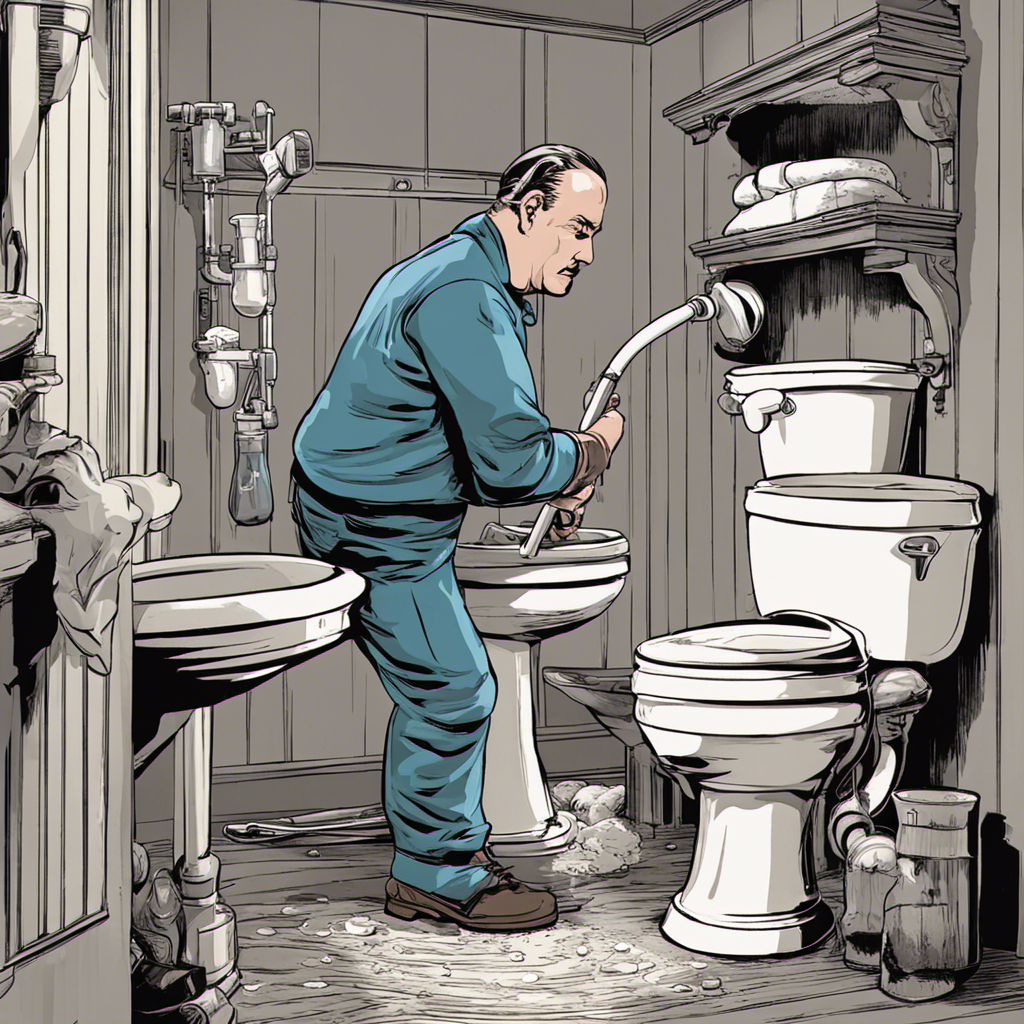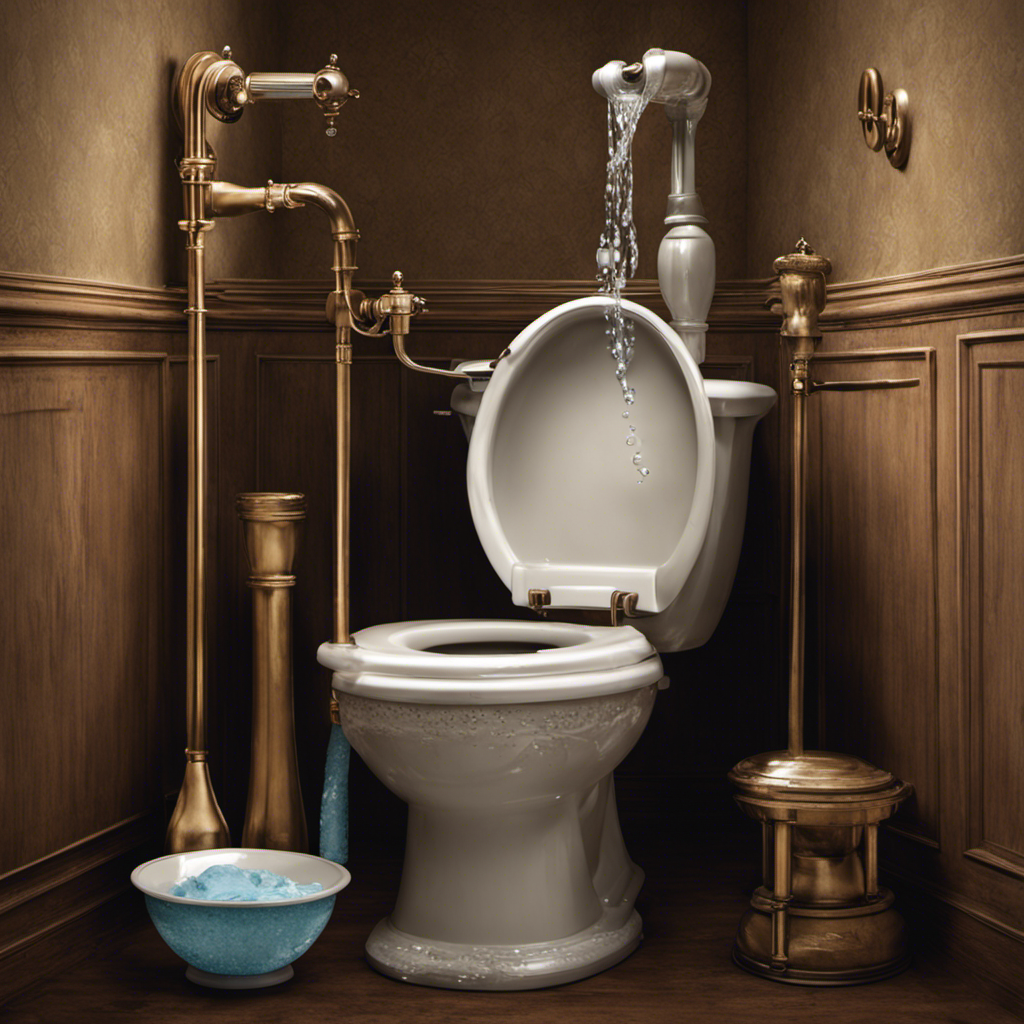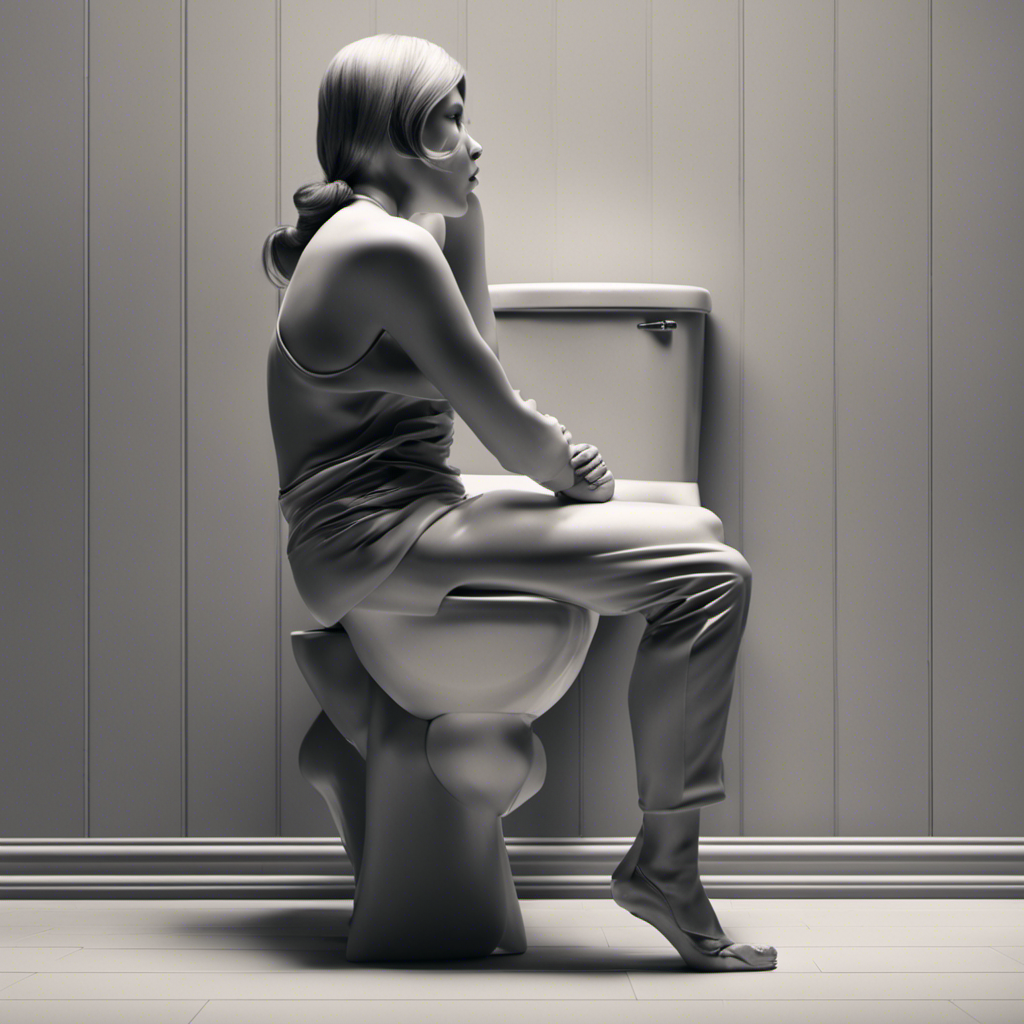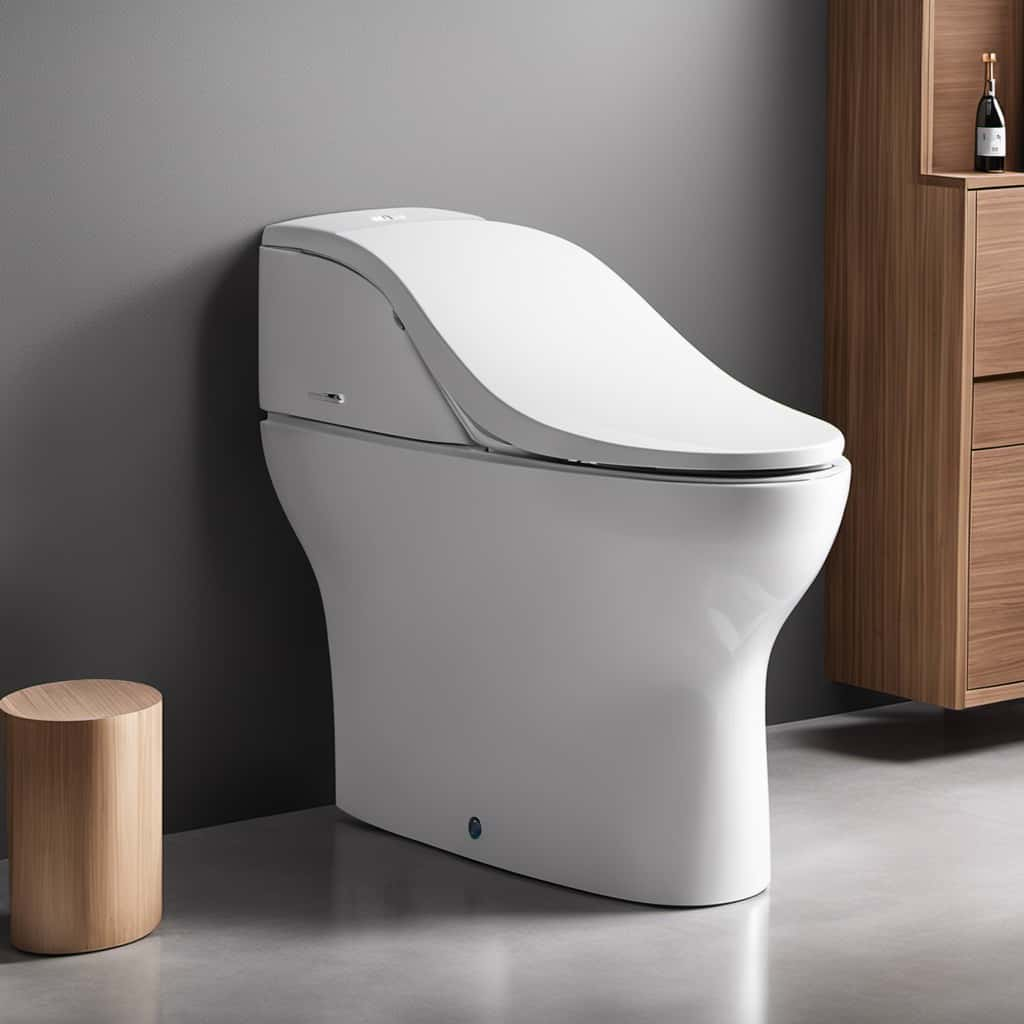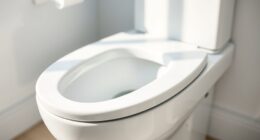I know, unclogging a toilet full of poop and water is not the most glamorous task, but sometimes it just has to be done. Don’t worry, I’ve got you covered with a step-by-step guide on how to tackle this messy situation.
With a plunger, a toilet auger, or even a natural drain cleaner, you’ll be able to handle the clog like a pro.
And if all else fails, we’ll discuss when it’s time to call in a professional.
Let’s get started!
Key Takeaways
- Promptly addressing a clogged toilet is important to prevent further damage or overflow.
- Having the right tools, such as a plunger with a flange or accordion-style design, is crucial for effective unclogging.
- Proper plunger technique, including creating a tight seal and using pushing and pulling motions, is essential for unclogging.
- Consider using alternative methods like a toilet auger or natural drain cleaner, and if needed, seek professional help from a plumber.
Understanding the Problem
Before proceeding with any unclogging techniques, it’s important to understand the problem at hand. A clogged toilet can be a messy and frustrating situation, but with some knowledge, you can tackle it effectively.
Common causes of a clogged toilet include flushing excessive toilet paper, foreign objects, or a buildup of waste over time. Signs of a clogged toilet may include water rising to the rim when flushed, slow draining, or a complete inability to flush.
It’s important to address the issue promptly to prevent any further damage or overflow. By recognizing these common causes and signs, you can take the necessary steps to unclog your toilet and restore its functionality.
Gathering the Necessary Tools
To gather the necessary tools for this task, you’ll need a plunger and a pair of rubber gloves.
Here are three crucial tips for unclogging a toilet full of poop and water:
-
Protect yourself: Put on a pair of rubber gloves before starting any DIY solution. This will prevent any potential contamination and keep you safe from germs.
-
Get the right plunger: Make sure you have a plunger with a flange or an accordion-style design. These types are specifically designed for unclogging toilets and provide better suction.
-
Create a seal and plunge: Place the plunger over the drain hole and firmly press down to create a seal. Start plunging vigorously up and down to dislodge the clog. Repeat this motion several times until the water starts to drain.
Following these unclogging tips and using DIY solutions can help you resolve the issue effectively.
Using a Plunger
When it comes to using a plunger to unclog a toilet, there are a few key points to keep in mind.
First, it’s important to use the proper plunger technique to effectively clear the blockage. This involves creating a tight seal around the drain and using a combination of pushing and pulling motions to dislodge the clog.
Additionally, taking steps to prevent future clogs can save you from the hassle and mess of dealing with a backed-up toilet. This can include being mindful of what you flush down the toilet and regularly maintaining the plumbing system.
Proper Plunger Technique
You’ll need to position the plunger over the clogged toilet drain and firmly push down to create a tight seal. Once the seal is formed, follow these steps to unclog your toilet:
-
Apply downward pressure: Push and pull the plunger vigorously to create suction and pressure, which will help dislodge the clog.
-
Keep the rhythm: Maintain a steady rhythm while plunging, ensuring the water in the toilet bowl moves back and forth.
-
Check for success: After several plunges, flush the toilet to see if the clog has cleared. If not, repeat the plunging process until the water drains properly.
To prevent toilet clogs in the future, consider these alternative methods:
-
Use a toilet auger: This tool can reach deeper into the pipes to remove stubborn clogs.
-
Try a homemade solution: Pour a mixture of hot water and dish soap into the toilet and let it sit for a while before flushing.
-
Install a drain strainer: This prevents objects like paper towels or sanitary products from entering the toilet drain and causing clogs.
Preventing Future Clogs
Consider using a drain strainer to prevent future clogs in your toilet. A drain strainer is a simple and effective tool that helps to catch debris and prevent it from entering your toilet’s pipes. By installing a drain strainer, you can significantly reduce the chances of experiencing clogs and the need for frequent unclogging.
Toilet maintenance is an essential part of keeping your bathroom functioning smoothly. Here are a few DIY plumbing tips to help you maintain your toilet:
| Tip | Description |
|---|---|
| Regular cleaning | Clean your toilet regularly using a toilet brush and cleaner to prevent the buildup of debris and grime. |
| Proper flushing | Make sure to flush only appropriate materials down the toilet, such as toilet paper and human waste. Avoid flushing non-flushable items like wipes or feminine products. |
| Check the water level | Periodically check the water level in your toilet tank to ensure it is at the recommended level. Adjust the float valve if necessary. |
Trying a Toilet Auger
First, grab the toilet auger and position it inside the clogged toilet bowl. This tool is specifically designed to clear stubborn clogs and can be a reliable alternative to other methods.
Here are the pros and cons of using a toilet auger:
-
Pro: Effective – A toilet auger can quickly break up and remove tough clogs, ensuring a clear flow of water.
-
Pro: Versatile – It can reach deep into the toilet drain and navigate around curves, making it suitable for various toilet designs.
-
Con: Potential damage – If not used correctly, a toilet auger can scratch the porcelain surface of the toilet bowl, causing aesthetic damage.
To use the toilet auger, simply rotate the handle while pushing the cable down into the drain. Continue until you feel resistance, then retract the cable and flush the toilet to test if the clog is cleared.
Utilizing a Natural Drain Cleaner
If you’re looking for an eco-friendly solution, try using a natural drain cleaner to tackle stubborn clogs. Here’s a step-by-step guide on how to create your own DIY drain cleaner using ingredients you probably already have at home.
First, gather baking soda, vinegar, and hot water. Start by pouring half a cup of baking soda into the clogged toilet. Let it sit for a few minutes to break down the blockage.
Then, pour one cup of vinegar into the toilet, followed by hot water. The chemical reaction between the baking soda and vinegar will help dissolve the clog.
Calling in a Professional
When it comes to dealing with a clogged toilet filled with poop and water, sometimes calling in a professional can be the best option. The cost of professional help may vary depending on the plumber and the severity of the clog, but it can save you time and frustration in the long run.
A professional not only has the expertise to quickly and effectively clear the clog, but also has the necessary equipment to tackle even the toughest blockages.
Cost of Professional Help
Hiring a professional plumber can be expensive, but it may be necessary to unclog a toilet that is full of poop and water. When considering the cost of professional help, it’s important to weigh the options and consider the alternatives.
Here is a cost comparison and some DIY options to help you make an informed decision:
-
Cost Comparison:
- Professional plumber: The average cost for a plumber to unclog a toilet can range from $100 to $300, depending on the severity of the clog and the plumber’s rates.
- DIY options: Unclogging a toilet yourself can be cost-effective, as it only requires basic tools and materials that are readily available at home.
-
DIY Options:
- Plunger: Using a plunger is a common and effective method to unclog a toilet. It creates suction and pressure to dislodge the blockage.
- Toilet auger: If the plunger doesn’t work, a toilet auger can be used to break up and remove the clog.
- Homemade solutions: A mixture of hot water, dish soap, and baking soda can be poured into the toilet to help dissolve the clog.
Time Saved by Professional
To save yourself time, consider hiring a professional plumber who can quickly resolve the issue. When it comes to unclogging a toilet full of poop and water, time efficiency is crucial. While there are DIY alternatives available, they may not guarantee the same level of speed and effectiveness. Let’s take a look at a comparison between DIY and professional services:
| DIY Alternatives | Professional Plumber |
|---|---|
| Plunger | High-pressure jet |
| Chemical cleaners | Plumbing snake |
| Hot water | Auger |
Although these DIY alternatives can be helpful, they might require multiple attempts and take longer to achieve the desired result. On the other hand, a professional plumber has expertise and specialized equipment, enabling them to unclog the toilet quickly and efficiently. By hiring a professional, you can save precious time and avoid potential frustrations.
Expertise and Equipment Needed
If you want the job done quickly and effectively, a professional plumber has the expertise and equipment needed to resolve the issue.
Here are three reasons why hiring a professional plumber is the best choice:
-
Expertise: A professional plumber has undergone extensive training and has years of experience in dealing with plumbing issues. They have the knowledge and skills to accurately diagnose the problem and apply the appropriate troubleshooting techniques.
-
Specialized Equipment: Professional plumbers have access to specialized tools and equipment that are designed to tackle even the most stubborn clogs. These tools allow them to efficiently and effectively remove the blockage without causing any further damage to your plumbing system.
-
Time and Money Saved: By hiring a professional plumber, you can save yourself the time and hassle of trying to fix the problem on your own. Additionally, their expertise and efficient work will ensure that the issue is resolved quickly, saving you money in the long run.
Frequently Asked Questions
Can I Use a Regular Plunger to Unclog a Toilet?
Yes, I can use a regular plunger to unclog a toilet. It’s a simple and effective method. However, if the clog is stubborn, I can also try using a toilet snake or pouring hot water to break it up.
How Long Should I Wait Before Trying a Natural Drain Cleaner?
I usually wait about 30 minutes before trying a natural drain cleaner. It gives the cleaner enough time to work and break down the clog. However, effectiveness may vary depending on the type of clog and the specific cleaner used.
Are There Any Safety Precautions I Should Take When Using a Toilet Auger?
When using a toilet auger, it is important to take safety precautions. Proper technique is crucial to avoid injury and effectively unclog the toilet. Let me explain the steps in detail.
What Are Some Signs That Indicate I Should Call in a Professional Plumber?
If there are signs of a serious toilet clog, such as repeated backups or slow draining, it’s time to hire a professional plumber. They have the tools and expertise to handle the job safely and effectively.
Is It Possible to Prevent Future Toilet Clogs?
Can I prevent future toilet clogs? Yes, by taking preventive measures and practicing regular toilet maintenance. By being mindful of what goes down the drain and using a plunger when needed, clogs can be avoided.
Conclusion
Well, there you have it folks! After going through all the steps and techniques to unclog a toilet full of poop and water, you should now be equipped with the knowledge to tackle this messy situation.
From understanding the problem to gathering the necessary tools, using a plunger, trying a toilet auger, utilizing a natural drain cleaner, and even calling in a professional if needed, you are now a true master of toilet unclogging.
So, next time you find yourself knee-deep in a poop-filled toilet, fear not! You have the power to conquer the clog and restore peace to your bathroom kingdom.
Happy unclogging!
